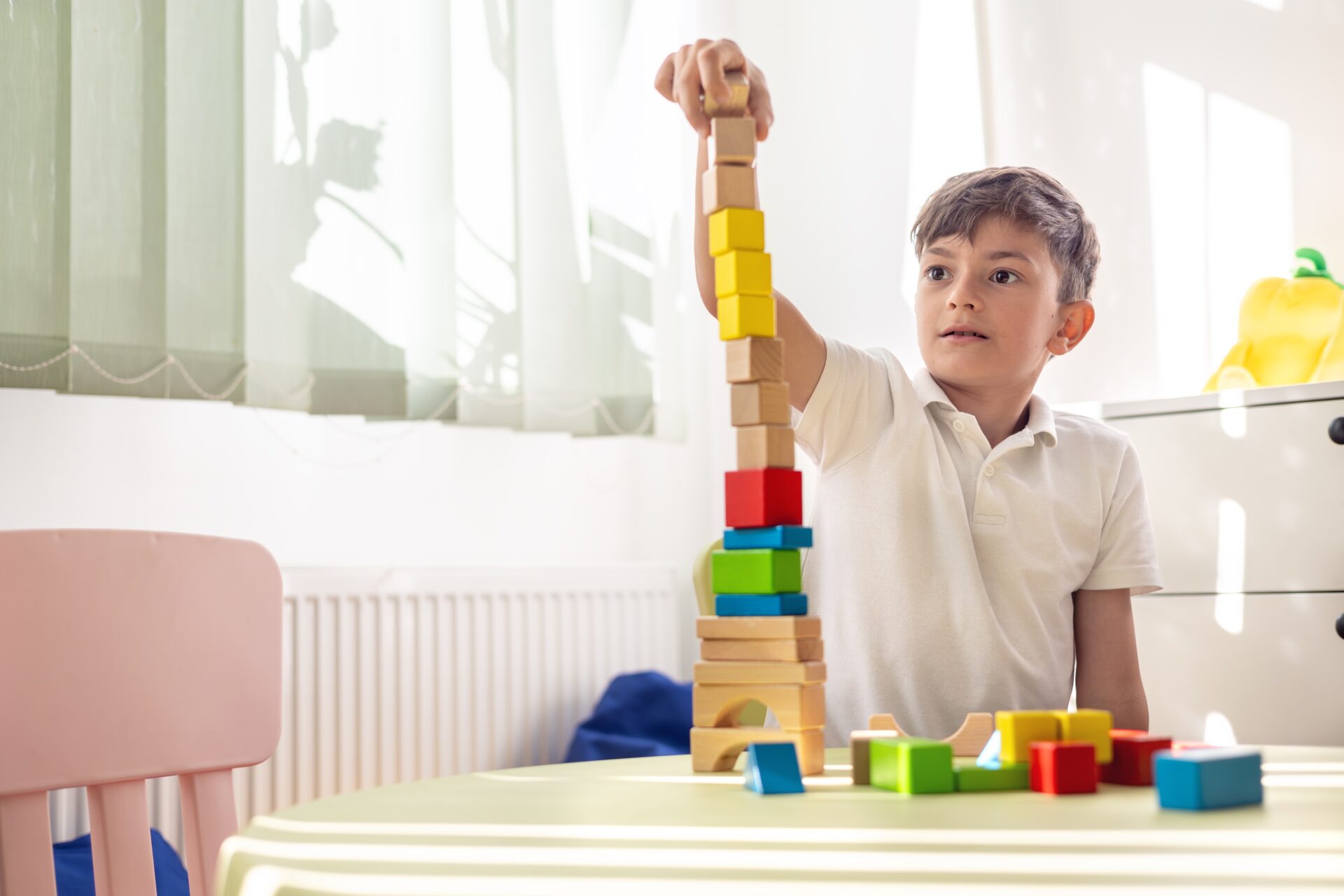Mental Health and Well-Being in Children
Children’s mental health is defined by the way kids think, feel, and act, in addition to how they handle stress, relate to others, or make healthy choices. Supporting children’s mental health, even from their earliest years into adulthood, involves continuously nurturing their emotional, psychological, and social well-being at every stage. The impact of this support is profound and long-lasting.
Promoting positive mental health in children creates a foundation for lifelong resilience and well-being. This foundation helps them develop into emotionally healthy adults who can navigate life’s challenges effectively while also living deeply fulfilling and meaningful lives.

Understanding Children’s Mental Health
Mental health in children refers to their psychological and emotional development, including the development of their social and behavioral regulation skills from infancy into early adulthood. Childhood mental health isn’t just high-stakes for parents or families, it’s also a growing health and psychological crisis with the most vulnerable lives hanging in the balance.
According to the Centers for Disease Control and Prevention, approximately one in six children between the ages of two to eight years old has a mental, behavioral, or developmental disorder [1]. These conditions can affect children across all backgrounds, though certain factors may increase vulnerability. For instance, in children experiencing significant adverse events like parental divorce, abuse, or the effects of alcoholic parents or addicted parents, the risk of developing mental health challenges increases substantially.
However, these challenges can sometimes be difficult to distinguish or diagnose because children express mental health concerns differently than adults. While adults might verbalize feelings of sadness or anxiety, children often demonstrate their struggles through behavioral changes, physical complaints, academic difficulties, or social struggles. Young children in particular rely on behaviors rather than words to communicate distress.
Pediatrician and childhood trauma expert Dr. Nadine Burke Harris explains, “Children’s behaviors speak the words their mouths cannot. Adults must learn to hear the language of behavior in order to understand what children are truly communicating” [2].
The brain’s remarkable plasticity during childhood creates vulnerability to stress, but it also has an exceptional capacity for healing and growth. This neurological flexibility in childhood provides an important window for building strong mental health foundations and addressing emerging concerns before they become entrenched patterns that stretch far into adulthood.
Common Mental Health Concerns in Children
Children can experience many of the same mental health conditions as adults, though symptoms often present differently based on developmental stage or age.
Anxiety
Anxiety disorders rank among the most common childhood mental health concerns, affecting approximately 7% of children aged 3-17 years [3]. Children with anxiety might display signs of excessive worrying, fear of separation from parents, or intense distress in social situations. Some children with anxiety even develop specific fears that significantly impact their daily functioning. For example, school phobia can lead to school avoidance and disruptions in their learning and education.
Depression
Depression is also a common mental health concern for children, affecting approximately 4% of children [1]. That percentage, however, increases dramatically during adolescence. Unlike adult depression which is often characterized by persistent sadness, children with depression might appear irritable, bored, or disinterested in activities they previously enjoyed. The consequences of childhood depression can be serious, particularly among teens. For example, teenage depression can lead to serious consequences like substance use, harmful risk-taking behaviors, and even suicidal thoughts.
ADHD
Attention-Deficit/Hyperactivity Disorder (ADHD) is also pervasive and affects about 11% of school-age children, with symptoms typically emerging before age 12 [4]. Children with ADHD have trouble with attention, impulse control, and sometimes hyperactivity, and all of these symptoms can significantly impact learning, social relationships, and self-esteem.
Trauma
Beyond more widely recognized conditions, children who experience adverse events may develop specific trauma responses that affect their mental health. Trauma-related or trauma-specific disorders develop following exposure to frightening or dangerous experiences, which may produce nightmares, flashbacks, avoidance behaviors, and emotional numbing. These trauma symptoms can significantly impact a child’s ability to engage in normal activities, form healthy relationships, and progress developmentally. Like other mental health concerns, early identification and appropriate intervention for trauma-related disorders are essential for helping children recover and thrive.
Warning Signs of Mental Health Problems in Kids
While children may experience many of the same mental health issues that adults struggle with, signs indicating that it’s time to seek help often look very different in children. As a result, recognizing mental health concerns in children requires early, proactive attentiveness to behavioral, emotional, physical, and social changes that can happen either very quickly or slowly over time.
Behavioral Warning Signs
While occasional emotional outbursts or temporary behavior changes usually represent normal development, persistent patterns that interfere with functioning warrant attention from caregivers and healthcare providers.
For children, behavioral warning signs indicating a mental health concern often include [5]:
- Significant changes in school performance
- Excessive worry or anxiety
- Frequent nightmares or sleep problems
- Persistent disobedience or aggression
- Frequent temper tantrums beyond developmentally appropriate ages
- Hyperactivity or constant movement beyond what seems typical
- Persistent difficulty concentrating or sitting still
Emotional Warning Signs
Emotional indicators that might signal mental health concerns include feelings of sadness lasting more than two weeks, withdrawal from friends and activities, overwhelming fears, extreme mood swings, hopelessness, and increased sensitivity to rejection.
Physical Warning Signs
Physical manifestations often accompany emotional distress in children, as they often lack the kind of ‘adult’ vocabulary skills required to express psychological pain. Frequent headaches or stomach aches without medical cause, changes in appetite, unexplained weight loss, or frequent fatigue all might indicate underlying mental health concerns.
Social Warning Signs
Social changes can also be an important indicator that a child is struggling, such as declining interest in previously enjoyed activities, deteriorating relationships with peers, or increasing isolation. For school-aged children, academic performance often reflects emotional well-being, with unexplained declining grades potentially indicating underlying distress, especially when other warning signs are present [5].
In general, age significantly influences the ways mental health concerns manifest. For example,
- Preschoolers might express anxiety through separation distress or regression in previously mastered skills.
- School-aged children might show perfectionism or excessive worry about performance.
- Adolescents may display risk-taking behaviors, substance experimentation, or significant mood fluctuations.
Knowing what to look for at each developmental stage helps parents and caregivers catch problems early when treatment and intervention are most likely to have a positive impact.
How to Raise Mentally Strong Kids
Resilience is the ability to adapt in the face of adversity. It can be actively cultivated in children, and it is one of many protective factors against poor mental health. Supporting children’s mental health involves more than just responding to issues after they develop. It also involves developing internal and external protective factors that make mental health challenges unlikely in the first place.
Internal Skills
Internal protective factors help guard children against mental health struggles throughout their lives. For example, social-emotional skills enable kids to navigate relationships and understand their own emotions, while problem-solving and self-regulation skills help them tackle challenges and manage their impulses and emotions. These internal resources form a strong psychological foundation and sense of self-worth upon which children can build mental resilience.
Home and School
Families promote resilience and well-being through a balanced approach of warmth alongside appropriate structure. When parents establish clear expectations while maintaining open dialogue about emotions, children develop stronger coping mechanisms. Implementing consistent routines strengthens this foundation by providing the security children need to thrive.
Beyond the home environment, schools play a complementary role in children’s mental health. Educational settings that prioritize social-emotional learning create spaces where students experience genuine connection. These positive learning environments contribute significantly to children’s overall well-being by establishing contexts where each child feels safe and valued [6].
In the Community
Communities also play a role. Universal prevention strategies transcend socio-economic barriers and ultimately benefit all children through things like school-based programs, positive parenting resources, and community-wide initiatives that support healthy development. Targeted prevention tools provide another layer of support for children with specific risk factors like poverty or trauma.
Whether in the home, at school, or across the community, intervention and prevention are most effective when deployed early. Early intervention not only addresses emerging concerns before they escalate but also strengthens a child’s resilience, potentially altering their developmental trajectory toward lifelong mental well-being.
Supporting Children Who Struggle
Supporting children with mental health needs requires a combination of approaches tailored to their developmental stage and specific concerns. Effective support begins with creating environments where children feel safe expressing their emotions without judgment or punishment.
Teaching children coping strategies provides practical, ‘kid-friendly’ tools for managing difficult emotions.
Age-appropriate coping strategies for children include:
- Deep breathing exercises using child-friendly imagery (like “balloon breathing”)
- Progressive muscle relaxation adapted for younger minds
- Mindfulness activities focused on present-moment awareness
- Creating calm-down spaces with soothing sensory tools
- Expressive outlets through art, music, or movement
- Simple cognitive reframing for older children (“helpful thoughts”)
By building emotional literacy, children can recognize and name their feelings, which is a crucial first step in effectively managing them. Simple practices like “feelings check-ins,” emotion charts, or storytelling about emotional experiences help children develop the vocabulary for internal states that might otherwise emerge as problematic behaviors.
When concerns persist, despite supportive home environments and effective coping strategies, professional help may be necessary. Pediatric psychiatry for children’s mental health offers specialized approaches including play therapy, cognitive-behavioral therapy adapted for children, family therapy, and medication (when appropriate and prescribed by a qualified pediatric provider). These evidence-based treatments provide effective options for children struggling with mental health concerns. As always, early intervention is best, especially when it comes to children.
Technology and Kids’ Mental Health
Technology and media increasingly influence children’s mental health as digital experiences become integrated into daily life. This relatively new dimension of childhood development presents both challenges and opportunities for supporting children’s psychological well-being.
Most notably, screen time affects developing minds differently than adult brains, with both quantity and content quality playing important roles. Research suggests excessive screen use in children, especially very young children, correlates with mental health concerns like attention problems, sleep disruption, and reduced face-to-face social interaction [7].
In particular, social media presents particular considerations for older children and adolescents. While some believe these platforms can facilitate positive social connection and identity exploration, they also introduce risks including cyberbullying, unhealthy social comparison, and exposure to inappropriate content [7].
Teaching digital citizenship and maintaining open communication about online experiences helps children navigate these environments safely. Children should learn to critically evaluate media messages about body image, success, happiness, and social norms so they can counteract potentially harmful influences. When children learn to question unrealistic portrayals and recognize manipulative content, they can develop psychological protections against media-driven insecurities.
Ultimately, however, it is up to parents and caregivers to establish clear boundaries and rules for technology use (ideally modeling balanced habits themselves). It is also essential to prioritize in-person social experiences that contribute to strong social and emotional development and well-being. Tech use can also be positive, such as regulated therapeutic apps or using it for online peer support.
Lifelong Well-Being Starts in Childhood
Children’s mental health requires ongoing attention and commitment from all of the adults in their lives, from infancy through adulthood. Promoting well-being in children during these formative years helps parents, caregivers, families, and communities create safe, supportive, and nurturing environments where children can thrive psychologically and physically.
The good news about mental health for children is their remarkable capacity for growth and healing during the developmental years. Even children experiencing significant mental health concerns typically respond well to treatment, especially when intervention occurs early and includes family involvement. With the appropriate support and early intervention, most children can navigate mental health challenges successfully and develop resilience that will serve them throughout their lives, well beyond childhood.
- Centers for Disease Control and Prevention. (2025). Data and statistics on children’s mental health. cdc.gov/children-mental-health/data-research/?CDC_AAref_Val=https://www.cdc.gov/childrensmentalhealth/data.html. Accessed April 4, 2025.
- Burke Harris, N. (2018). The deepest well: Healing the long-term effects of childhood adversity. Houghton Mifflin Harcourt. nnlm.gov/reading-club/book/deepest-well. Accessed April 4, 2025.
- National Institute of Mental Health. (2023). Mental health statistics: Children and adolescents. nimh.nih.gov/health/statistics/mental-illness.shtml#children. Accessed April 4, 2025.
- Children and Adults with Attention-Deficit/Hyperactivity Disorder (CHADD). (n.d.). Understanding ADHD. chadd.org/understanding-adhd/. Accessed April 4, 2025.
- American Academy of Child & Adolescent Psychiatry. (2022). Warning signs of mental illness in children and adolescents. aacap.org/AACAP/Families_and_Youth/Facts_for_Families/FFF-Guide/When-To-Seek-Help-For-Your-Child-024.aspx. Accessed April 4, 2025.
- Bronfenbrenner, U. (2005). Making human beings human: Bioecological perspectives on human development. Sage Publications.
- Avci, H., Baams, L., & Kretschmer, T. (2024). A systematic review of social media use and adolescent identity development. Adolescent Research Review. doi.org/10.1007/s40894-024-00251-1. Accessed April 4, 2025.
The Clinical Affairs Team at MentalHealth.com is a dedicated group of medical professionals with diverse and extensive clinical experience. They actively contribute to the development of content, products, and services, and meticulously review all medical material before publication to ensure accuracy and alignment with current research and conversations in mental health. For more information, please visit the Editorial Policy.
MentalHealth.com is a health technology company guiding people towards self-understanding and connection. The platform provides reliable resources, accessible services, and nurturing communities. Its purpose is to educate, support, and empower people in their pursuit of well-being.
Briana Casali, Ph.D. is an experienced editor and professional writer with a background in academic editing and journalism for high-growth organizations.
Holly Schiff, Psy.D., is a licensed clinical psychologist specializing in the treatment of children, young adults, and their families.
The Clinical Affairs Team at MentalHealth.com is a dedicated group of medical professionals with diverse and extensive clinical experience. They actively contribute to the development of content, products, and services, and meticulously review all medical material before publication to ensure accuracy and alignment with current research and conversations in mental health. For more information, please visit the Editorial Policy.
MentalHealth.com is a health technology company guiding people towards self-understanding and connection. The platform provides reliable resources, accessible services, and nurturing communities. Its purpose is to educate, support, and empower people in their pursuit of well-being.


